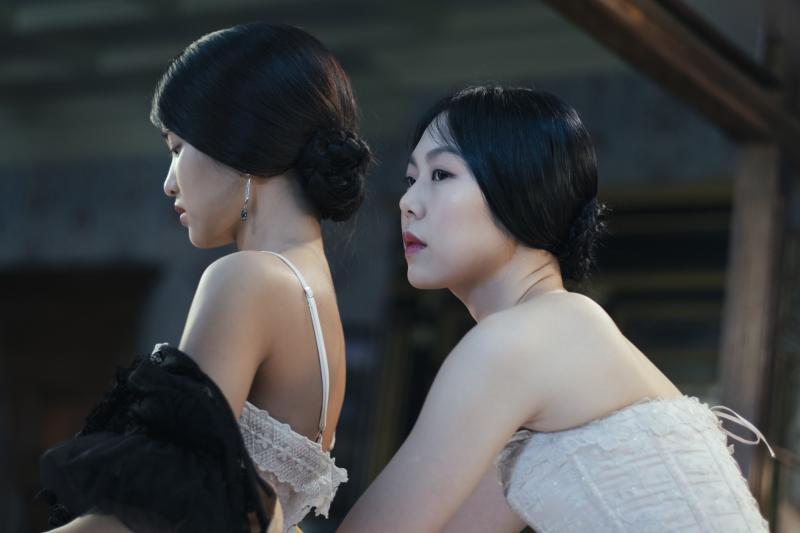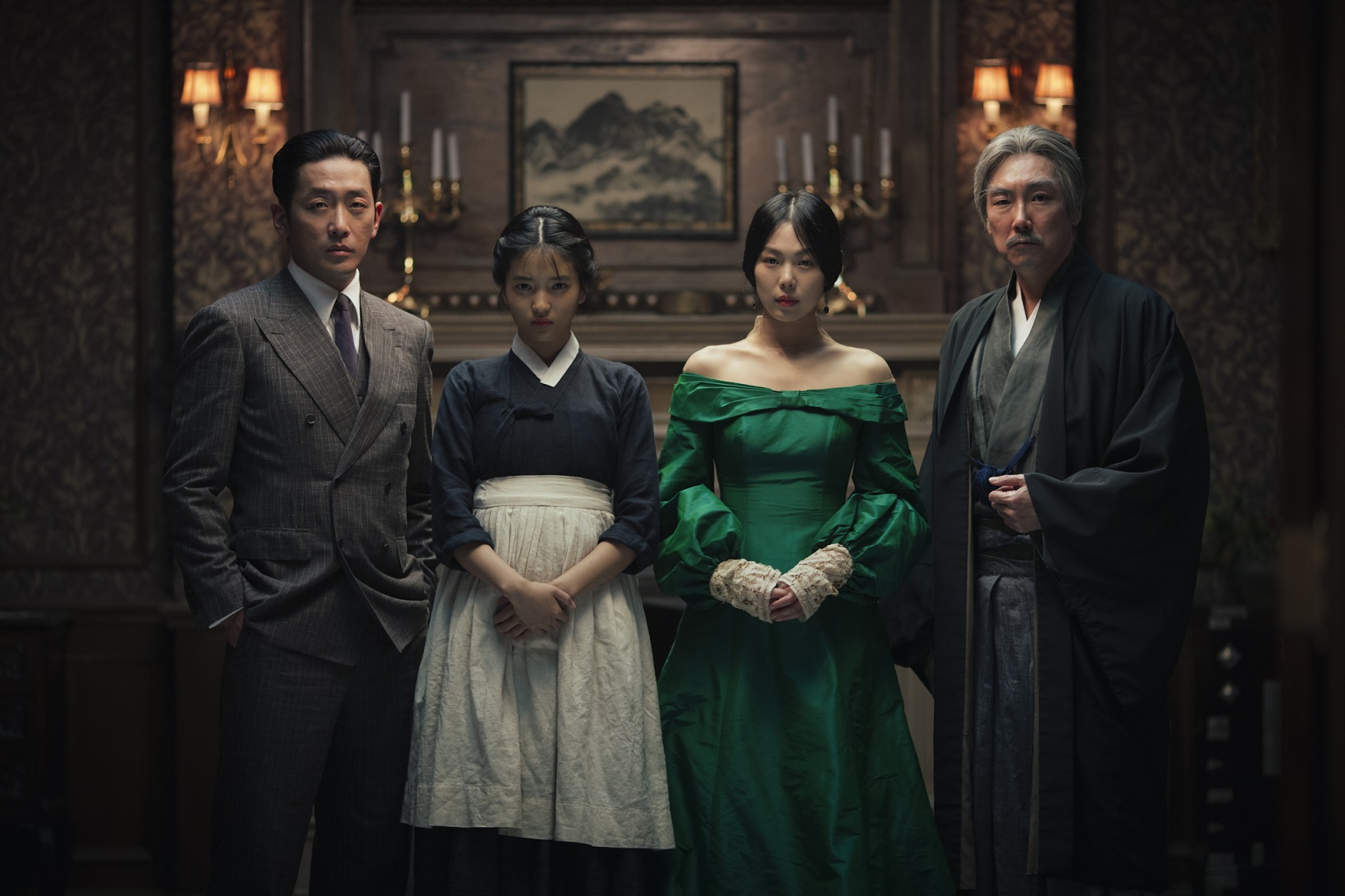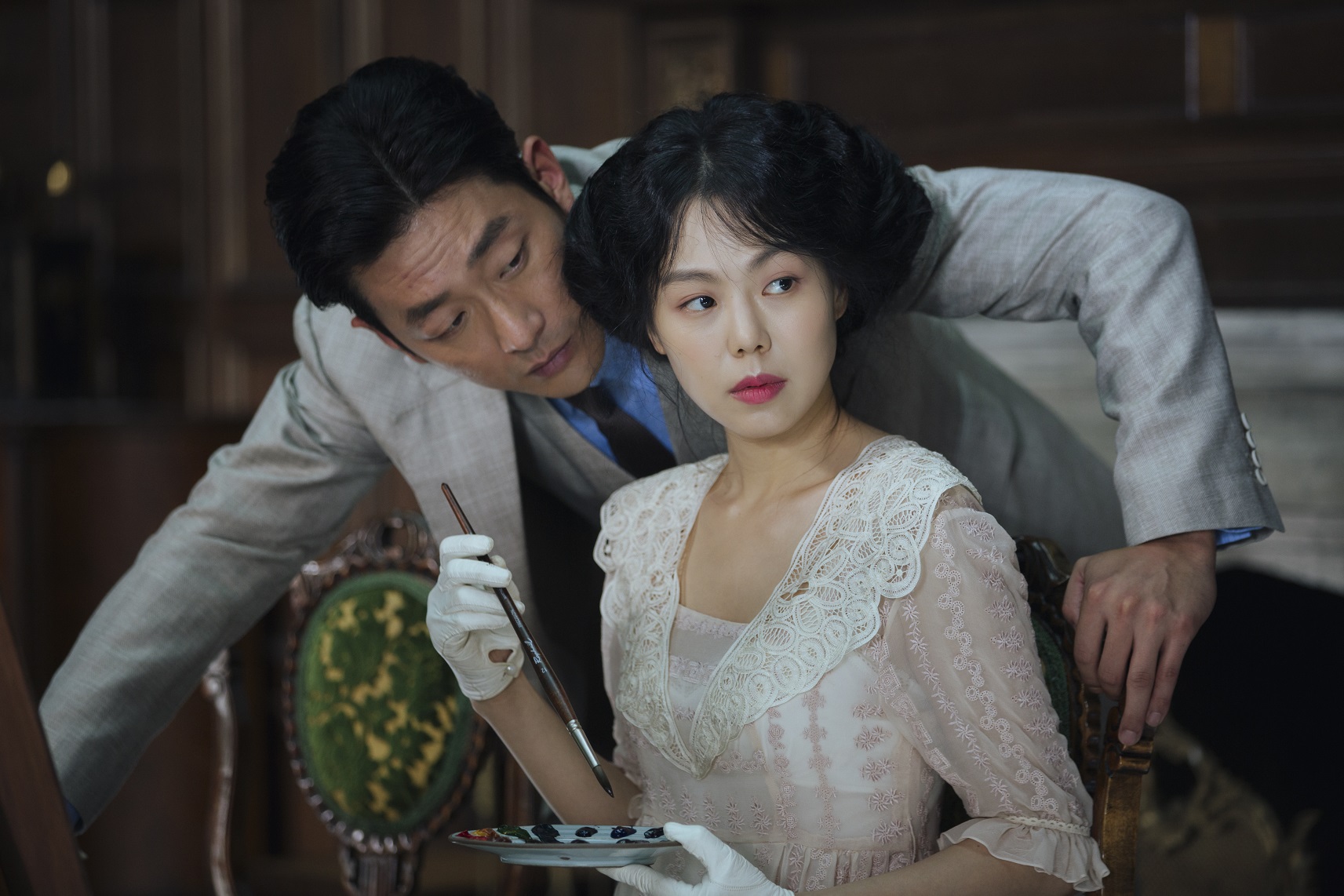The Handmaiden review - opulently lurid | reviews, news & interviews
The Handmaiden review - opulently lurid
The Handmaiden review - opulently lurid
Park Chan-wook's sensual reimagining of Sarah Waters' intricate lesbian thriller

Park Chan-wook is a Korean decadent and moralist who’d have plenty to say to Aubrey Beardsley.
Park himself calls The Handmaiden a “fan fiction” rewrite of Waters’ novel, but in transposing it to 1930s Korea, the Oldboy director sinks it deep into his own sensibilities. The country is a Japanese colonial outpost, where top-hatted Japanese toffs are sweatily entertained at the erotic literary soirees of Kouzuki (Cho Jin-Woong, pictured below, right, with Ha Jung-woo, Kim Tae-ri and Kim Min-hee), a wealthy Korean cravenly determined to pass as a Japanese nobleman. This baroque villain’s tongue is blackened by the ink of his pornographic library, and his heart similarly stained towards his niece, Lady Hideko (Kim Min-hee). In his sprawling, schizophrenic mansion, which mixes English Gothic and Asian grandeur, partitions part like veils or close like traps as its mysteries are penetrated, enclosing Hideko’s life. The plot is also a trap-doored maze, hinging on the arrival of Sookee (Kim Tae-ri) as Hideko’s handmaiden. We first see her in a working-class ghetto where permanent rain underlines the second-class nature of a subjugated country, and Sookee’s place in it. She is part of a clan of petty criminals, chief among them the Count (Ha Jung-woo, pictured below, left, with Kim Min-hee), another fake Japanese nobleman. He employs her help in an epic con, in which he’ll seduce the virginal Hideko into marriage, then dump her in an asylum and live off her dowry.
The plot is also a trap-doored maze, hinging on the arrival of Sookee (Kim Tae-ri) as Hideko’s handmaiden. We first see her in a working-class ghetto where permanent rain underlines the second-class nature of a subjugated country, and Sookee’s place in it. She is part of a clan of petty criminals, chief among them the Count (Ha Jung-woo, pictured below, left, with Kim Min-hee), another fake Japanese nobleman. He employs her help in an epic con, in which he’ll seduce the virginal Hideko into marriage, then dump her in an asylum and live off her dowry.
In the feverish hothouse of Kouzuki’s mansion, though, the lines of seduction quickly melt. The intimacy of handmaid and lady at bath and bedtime makes Sookee and Hideko fall for each other. Park brought a quivering, female-centred sexuality to his Nicole Kidman-starring US excursion Stoker, and dives right in here. The sex scenes, though not as physically exposed as, say, Blue Is the Warmest Colour, are extensive and frank, trampling Korean film taboos about homosexuality with heedless female need. The fleshy, sensual warmth of these lengthy scenes contrasts with the inky shadows of Kouzuki’s male porn parlour. The sex fuels and frees both women. But in a film which radically shifts perspectives twice, the question of who is really being liberated and who coldly tricked is never simple. Power, sexual and otherwise, also shifts with the camera’s angle. The Handmaiden’s final section is where the director and his regular female co-writer Chung Seo-kyung leave Waters behind, for an ultra-Park finale involving intricate vengeance and torture, and a giant octopus (the other half of a famous old Japanese erotic print of female congress, as well as raw dinner in Oldboy). This side of Park the perverse feminist may alienate some fans of Waters’ novel. The claustrophobic richness of the world he creates, in which Cho Sang-kyung’s ravishing costumes play a key part, anyway lingers in the mind more even than the plot. His film presents a cloistered, colonial system, burned down by women’s lust and love.
The Handmaiden’s final section is where the director and his regular female co-writer Chung Seo-kyung leave Waters behind, for an ultra-Park finale involving intricate vengeance and torture, and a giant octopus (the other half of a famous old Japanese erotic print of female congress, as well as raw dinner in Oldboy). This side of Park the perverse feminist may alienate some fans of Waters’ novel. The claustrophobic richness of the world he creates, in which Cho Sang-kyung’s ravishing costumes play a key part, anyway lingers in the mind more even than the plot. His film presents a cloistered, colonial system, burned down by women’s lust and love.
rating
Explore topics
Share this article
Add comment
The future of Arts Journalism
You can stop theartsdesk.com closing!
We urgently need financing to survive. Our fundraising drive has thus far raised £49,000 but we need to reach £100,000 or we will be forced to close. Please contribute here: https://gofund.me/c3f6033d
And if you can forward this information to anyone who might assist, we’d be grateful.

Subscribe to theartsdesk.com
Thank you for continuing to read our work on theartsdesk.com. For unlimited access to every article in its entirety, including our archive of more than 15,000 pieces, we're asking for £5 per month or £40 per year. We feel it's a very good deal, and hope you do too.
To take a subscription now simply click here.
And if you're looking for that extra gift for a friend or family member, why not treat them to a theartsdesk.com gift subscription?
more Film
 London Film Festival 2025 - crime, punishment, pop stars and shrinks
Daniel Craig investigates, Jodie Foster speaks French and Colin Farrell has a gambling habit
London Film Festival 2025 - crime, punishment, pop stars and shrinks
Daniel Craig investigates, Jodie Foster speaks French and Colin Farrell has a gambling habit
 I Swear review - taking stock of Tourette's
A sharp and moving tale of cuss-words and tics
I Swear review - taking stock of Tourette's
A sharp and moving tale of cuss-words and tics
 A House of Dynamite review - the final countdown
Kathryn Bigelow's cautionary tale sets the nuclear clock ticking again
A House of Dynamite review - the final countdown
Kathryn Bigelow's cautionary tale sets the nuclear clock ticking again
 theartsdesk Q&A: Idris Elba on playing a US President faced with a missile crisis in 'A House of Dynamite'
The star talks about Presidential decision-making when millions of lives are imperilled
theartsdesk Q&A: Idris Elba on playing a US President faced with a missile crisis in 'A House of Dynamite'
The star talks about Presidential decision-making when millions of lives are imperilled
 Urchin review - superb homeless drama
Frank Dillane gives a star-making turn in Harris Dickinson’s impressive directorial debut
Urchin review - superb homeless drama
Frank Dillane gives a star-making turn in Harris Dickinson’s impressive directorial debut
 Mr Blake at Your Service review - John Malkovich in unlikely role as an English butler
Weird comedy directed by novelist Gilles Legardinier
Mr Blake at Your Service review - John Malkovich in unlikely role as an English butler
Weird comedy directed by novelist Gilles Legardinier
 Don't Let's Go to the Dogs Tonight review - vivid adaptation of a memoir about a Rhodesian childhood
Embeth Davidtz delivers an impressive directing debut and an exceptional child star
Don't Let's Go to the Dogs Tonight review - vivid adaptation of a memoir about a Rhodesian childhood
Embeth Davidtz delivers an impressive directing debut and an exceptional child star
 One Battle After Another review - Paul Thomas Anderson satirises America's culture wars
Leonardo DiCaprio, Teyana Taylor, and Sean Penn star in a rollercoasting political thriller
One Battle After Another review - Paul Thomas Anderson satirises America's culture wars
Leonardo DiCaprio, Teyana Taylor, and Sean Penn star in a rollercoasting political thriller
 Steve review - educator in crisis
Cillian Murphy excels as a troubled headmaster working with delinquent boys
Steve review - educator in crisis
Cillian Murphy excels as a troubled headmaster working with delinquent boys
 Can I get a Witness? review - time to die before you get old
Ann Marie Fleming directs Sandra Oh in dystopian fantasy that fails to ignite
Can I get a Witness? review - time to die before you get old
Ann Marie Fleming directs Sandra Oh in dystopian fantasy that fails to ignite
 Happyend review - the kids are never alright
In this futuristic blackboard jungle everything is a bit too manicured
Happyend review - the kids are never alright
In this futuristic blackboard jungle everything is a bit too manicured

Comments
I thought it was totally